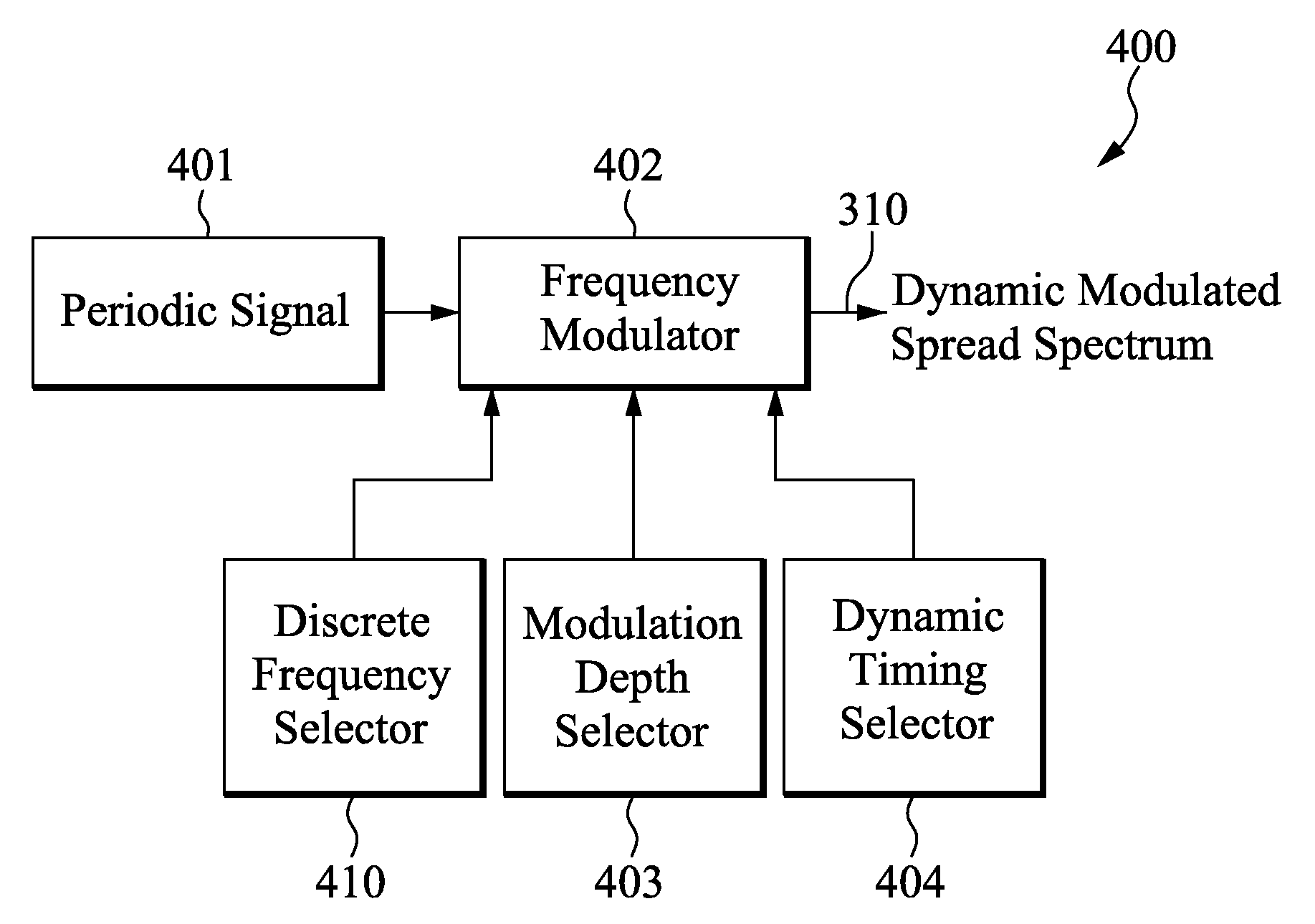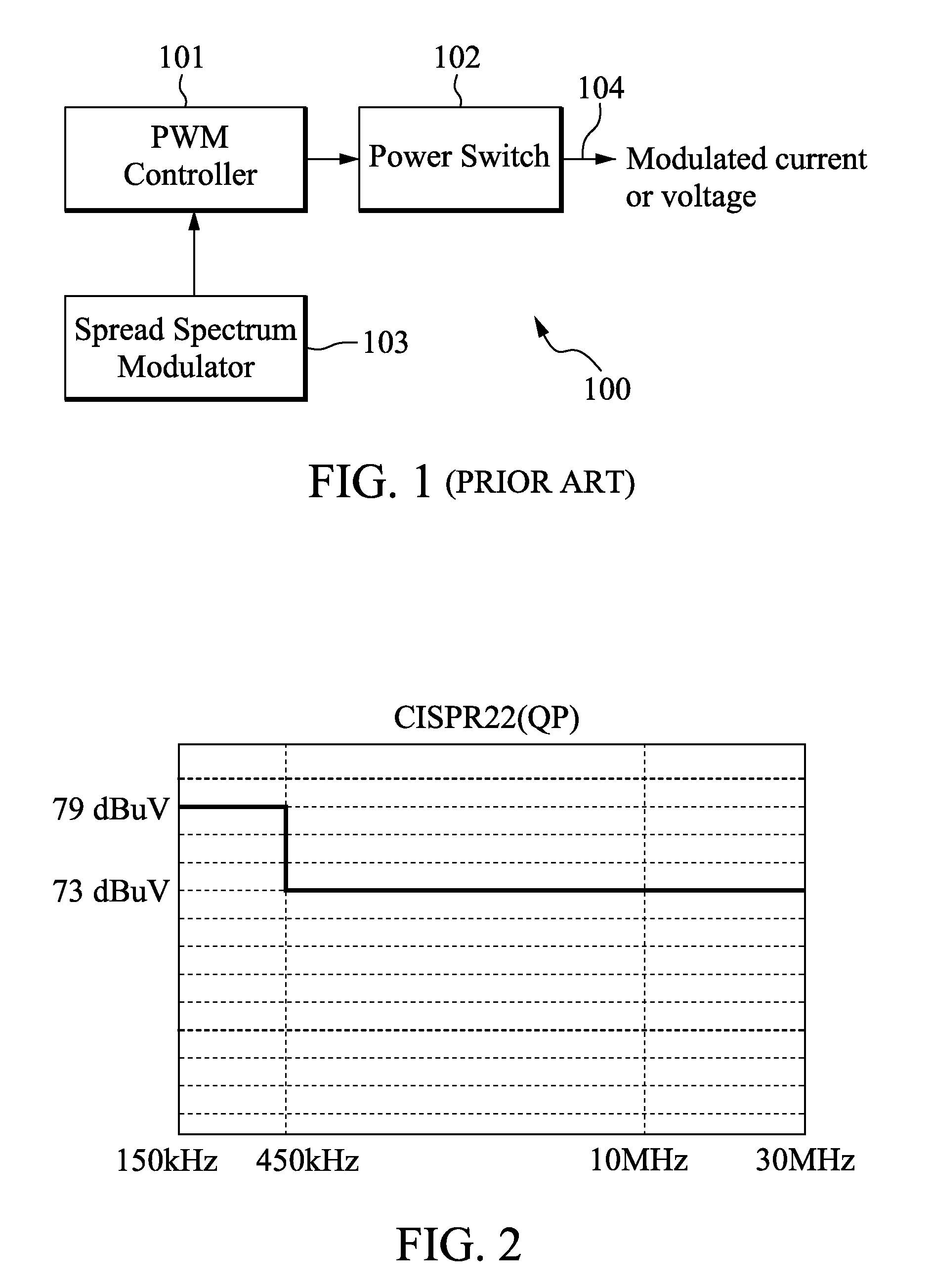Method and Apparatus for Dynamic Modulation
- Summary
- Abstract
- Description
- Claims
- Application Information
AI Technical Summary
Benefits of technology
Problems solved by technology
Method used
Image
Examples
first embodiment
[0034]Now refer to FIG. 5A which illustrates the timing of a dynamic modulator with modulation depth control only, dynamic modulator, in accordance with the present invention. The switching signal is frequency modulated at modulation depths δ1, δ2, δ3, . . . , δn over time which are set by modulator depth selector 403. The time duration (dwell time), set by dynamic timing selector 404, over which the modulated frequency remains at each value of δ determines the resulting time averaged amplitudes of the carrier frequency, its harmonics and their sidebands. 501, 502, 503, 504 and 505 represent the spread spectrum modulation depth values of δ1, δ2, δ3, . . . , δn and δ1 that are impressed on the switching frequency. The parameters td 506 and tr 507 are the dwell time and repetition period respectively. Parameter td 506 represents the time duration over which modulation depth δ1 is impressed on the switching frequency to effect spread spectrum modulation. Also, tdn 508 represents a gene...
second embodiment
[0036]Turning to FIG. 5B which illustrates the timing of a dynamic modulator with discrete frequency hopping control, dynamic modulator, in accordance with the present invention. It shows the concept of discrete frequency variation (hopping) for conducted and radiated emissions compliance when standard Quasi Peak (QP) detection methodologies for radiated and / or conducted EMI measurement are used. The switching frequency is shifted over a range of values f1, f2, f3, . . . , fn as represented by 521, 522, 523, 524 and 525. 506 represents the dwell time (td) at each value of the frequency and 507 represents the repetition period (tr) at each of the frequencies selected for hopping. The dwell time 506 may be set to be equal for all frequencies f1-fn, and f1 (i.e. 521-525), or it may be set to be varied for each frequency value 521-525. This idea is shown as the parameter tdn 508, where tdn is the dwell time at the nth frequency fn. The dwell time tdn 508 may or may not be equal to td 50...
third embodiment
[0037]As mentioned earlier, the discrete frequency hopping of dynamic modulator can operate independently or with modulation depth changes (or control). FIG. 5C illustrates the timing of this combined control, dynamic modulation. In FIG. 5C, the vertical axis is frequency and horizontal axis is time. The values and scale of frequency and time are for illustration only. During the first time interval td 506 (or dwell time), frequency f1 is set to 120 kHz and modulation depth δ1 501 is also applied. In the next time interval, frequency is shifted to 160 kHz while modulation depth δ2 502 is used. At the nth time interval tdn 508, the frequency fn is set to 80 kHz with modulation depth δn 504. Also, tdn 508 represents a general duration of the dwell time, and td 506 may or may not be equal to tdn 508. Note that the values of modulation depths (δ1 to δn) used in discrete frequency hopping control may be the same or different, periodically, non-periodically or randomly. They are used to f...
PUM
 Login to View More
Login to View More Abstract
Description
Claims
Application Information
 Login to View More
Login to View More - R&D
- Intellectual Property
- Life Sciences
- Materials
- Tech Scout
- Unparalleled Data Quality
- Higher Quality Content
- 60% Fewer Hallucinations
Browse by: Latest US Patents, China's latest patents, Technical Efficacy Thesaurus, Application Domain, Technology Topic, Popular Technical Reports.
© 2025 PatSnap. All rights reserved.Legal|Privacy policy|Modern Slavery Act Transparency Statement|Sitemap|About US| Contact US: help@patsnap.com



